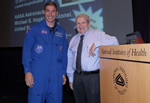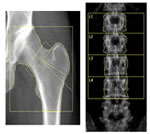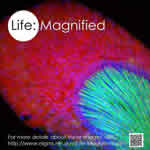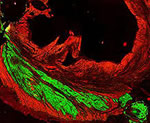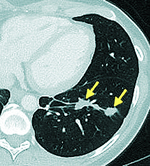Spotlight
Letter from Dr. Stephen I. Katz: Update on the NIAMS Long-Range Plan
Last year, I wrote about our efforts to update the Institute’s Long-Range Plan for fiscal years (FY) 2015–2019. When complete, our Long-Range Plan will outline the Institute’s perspective on research needs and opportunities within NIAMS’ mission, and will serve as a resource for all who are interested in NIAMS’ activities. Because we will continue to devote the majority of our extramural budget toward funding the best investigator-initiated research ideas, the new plan will encourage creative approaches for generating the scientific discoveries that will ultimately improve the health of the American public.
Image: Stephen I. Katz, M.D., Ph.D.
News
NASA Astronaut, NIH Officials Discuss Medical Research Being Done on Space Station
NASA astronaut Michael Hopkins met Dr. Stephen I. Katz, Director of the NIAMS, on Tuesday at the National Institutes of Health (NIH) campus in Bethesda, Maryland, where they discussed the importance of research taking place aboard the International Space Station, including NIH-funded investigations. Hopkins also made a presentation to a large group of NIH employees about the significant research conducted during his more than five months in orbit aboard the space station and how the orbiting complex is being used as a cutting-edge microgravity laboratory.
Image: Astronaut Mike Hopkins, left, and NIAMS Director Dr. Stephen I. Katz
Investigating the Causes of Chronic Itch: New Advances Could Bring Relief
Chronic itch, which occurs in many medical conditions and in response to certain drugs, affects millions of Americans, yet its causes are poorly understood. Now, investigators funded in part by the NIAMS have uncovered previously unknown pathways that trigger chronic itch, painting a clearer picture of the condition and suggesting novel therapeutic strategies.
Image: Activated BRAF protein (red) triggers itch. Credit: Zhou-Feng Chen, Ph.D., Washington Univ, St. Louis.
NIH and NSF Collaborate To Accelerate Biomedical Research Innovations Into the Marketplace
A collaboration between the National Science Foundation (NSF) and the NIH will give NIH-funded researchers training to help them evaluate their scientific discoveries for commercial potential, with the aim of accelerating biomedical innovations into applied health technologies.
NIH Takes Steps To Address Sex Differences in Preclinical Research
Over the past two decades, we have learned a great deal about how men and women respond differently to medications. This knowledge came after a concerted effort in the early 1990s to increase the number of women in clinical research funded by the NIH. Today, just over half of NIH-funded clinical research participants are women. Unfortunately, experimental design in cell and animal research has not always followed suit. An over-reliance on male animals, and neglect of attention to the sex of cells, can lead to neglect of key sex differences that should be guiding clinical studies, and ultimately, clinical practice. The NIH is taking action to address this shortfall.
Federal Pain Research Database Launched: Multi-Agency Effort Combines Pain Research Information in Easy-To-Use Database
The Interagency Pain Research Portfolio, a database that provides information about pain research and training activities supported by the federal government, has been launched by six federal agencies. Pain is a symptom of many disorders; chronic pain can present as a disease in and of itself. The economic cost of pain is estimated to be hundreds of billions of dollars annually in lost wages and productivity.
NIH Pain Consortium’s First Pain Care Curriculum Improves Clinical Skills
An online training module designed for the evaluation and care of chronic pain greatly improved medical student clinical skills, according to a report in the Journal of the American Geriatrics Society. The module, built by the University of Pittsburgh and using an elderly woman with chronic lower back pain as a case study, is the first curriculum resource created through the efforts of the NIH Pain Consortium’s Centers of Excellence in Pain Education program. The program was developed in response to the Affordable Care Act’s mandate to advance the science, research, care and education of pain.
Hormone Treatment Restores Bone Density for Young Women With Menopause-Like Condition: NIH Study Reveals Way To Improve Bone Health for Young Women With POI
Researchers have found that hormone replacement therapy in young women with primary ovarian insufficiency (POI) led to increases in their bone mineral density, restoring levels to normal. The study was supported by the Eunice Kennedy Shriver National Institute of Child Health and Human Development (NICHD), part of the NIH.
Image: Researchers at the NIH examined scans of the hip and lower spine to determine the effects of hormone treatment on bone mineral density of women with primary ovarian insufficiency.
NIH, PCORI Announce Major Award To Prevent Falls Injuries in Older People: Large, Multi-Site, Multi-Intervention Trial Will Test New Patient-Centered Strategies
Each year, 1 out of 3 adults age 65 and over falls. One-third of those falls result in moderate to severe injuries that can lead to further declines in health and loss of independence. Thousands of older adults die each year from such falls as well. To find effective, evidence-based strategies to address the personal and public health burden of these falls, the NIH and the Patient-Centered Outcomes Research Institute (PCORI) have joined to support a clinical trial to test individually tailored interventions to prevent fall-related injuries. The award, made by the National Institute on Aging (NIA) of the NIH and funded by PCORI as part of the Falls Injuries Prevention Partnership of the two organizations, is expected to total some $30 million over the five-year project.
Structured Physical Activity Program Can Help Maintain Mobility in Vulnerable Older People: NIH-Supported Study Is First To Demonstrate Exercise as Disability Prevention Strategy
A carefully structured, moderate physical activity program can reduce risk of losing the ability to walk without assistance, perhaps the single most important factor in whether vulnerable older people can maintain their independence, a study has found.
NIH Center Sets New Goals for Global Health Research and Training
Global health research and training efforts should focus on combatting the growing epidemic of noncommunicable diseases, better incorporating information technology into research and training, and more effectively converting scientific discoveries into practice in low-resource settings, according to the Fogarty International Center’s new strategic plan. Fogarty is the component of the NIH solely focused on supporting global health research and training, and coordinating international research partnerships across the agency.
A Look at Programs Targeting New Scientists
The strength of the biomedical research enterprise depends on new researchers becoming independent NIH-funded researchers, bringing fresh ideas and perspectives for solving scientific questions. The long training period, aging of the biomedical workforce and the fiscally challenging times all affect the ability of individuals to move from training positions into independent research positions.
Changes to the Biosketch
A major change is coming in how you portray your body of work when applying for NIH funds. With strong support from NIH leadership, a new biosketch format is rolling out. The new NIH biosketch emphasizes accomplishments instead of just a list of publications, which, as previously discussed, was questioned as the best way to showcase your scientific contributions.
NIH Director’s Blog
Snapshots of Life: A Fantastic Voyage, Inside the Airport
It’s not every day that you can take flight on a fantastic voyage without leaving the airport. But that’s what will happen if you visit the Life: Magnified exhibit currently on display at Washington Dulles International Airport. If you only glimpse the exhibit as you’re running to catch a flight, you’ll probably think it’s an art display: gorgeous modern photography. Look closer. You’ll find cells and other of life’s tiniest parts—blood, brain, and cancer cells; bacteria, viruses, even gecko toe hairs—all magnified up to 50,000 times, using the latest microscopy techniques.
Image: Confocal microscopy shows sox9b gene (green) in developing zebrafish fin. Credit: Jessica Plavicki, University of Wisconsin
Creative Minds: Path to Longevity May Start With … Bats and Mole Rats!
It started simply, with the analysis of a trace element in proteins. It led, through recognizing and following provocative patterns, to one of humanity’s greatest questions: What is the secret to a long life? This intriguing scientific path, traveled by NIH Pioneer Awardee Vadim Gladyshev, has brought together an assortment of mammals, great and small. It has relied upon a veritable global treasure hunt, with samples from Russian caves, East African tunnels and Arctic oceans. It was Gladyshev’s scientific acumen that mapped this path. And it is comparative genomic analysis that provided the vehicle he has used to travel along it—right up to the threshold of new insights into healthier, longer life.
Image: DNA studies are unraveling the secrets of animals such as (clockwise from top left): naked mole rat, bowhead whale, and Brandt’s bat.
Revisiting Resveratrol’s Health Claims
Over the past decade or so, a lot of us have been led to believe that certain indulgences—such as a glass of Pinot noir or a piece of dark chocolate—can actually be health-promoting. That’s because a number of studies had suggested that red wine, chocolate and other foods containing the antioxidant resveratrol might lower the risk of heart disease, cancer and other age-related maladies. But now comes word that a diet rich in resveratrol may not automatically translate into better health.
Image: Photo Credit: Jill George, NIH
Can Something in Young Blood Give a Boost to Old Brains?
Infusing blood from younger creatures into older ones in hopes of halting—or even reversing—the aging process may sound like a macabre scene straight out of “Game of Thrones.” However, several scientific studies have shown that when older animals receive blood from younger counterparts, it improves the function of stem cells throughout the body, boosting tissue regeneration and healing. What’s not been clear is whether this activity can also rejuvenate the brain’s cognitive powers.
Other Federal News
 How Long Should You Take Certain Osteoporosis Drugs?
How Long Should You Take Certain Osteoporosis Drugs?
Researchers at the U.S. Food and Drug Administration (FDA) have taken a close look at the long-term benefit of bisphosphonates, a class of medications widely prescribed to treat osteoporosis. An FDA review of clinical studies measuring the effectiveness of long-term bisphosphonate use shows that some patients may be able to stop using bisphosphonates after three to five years and still continue to benefit from their use.
FDA Allows Marketing of First Prosthetic Arm That Translates Signals From Person’s Muscles To Perform Complex Tasks
The FDA approved marketing of the DEKA Arm System, the first prosthetic arm that can perform multiple, simultaneous powered movements controlled by electrical signals from electromyogram (EMG) electrodes.
FDA’s “Voice of the Patient”: Listening to Those Most Affected by Their Disease and Treatments
Last year, the FDA began the Patient-Focused Drug Development program to more systematically obtain the patient perspective on certain diseases and their treatments. The effort is part of an FDA commitment under the fifth authorization of the Prescription Drug User Fee Act.
Indoor Tanning Raises Risk of Melanoma: FDA Strengthens Warnings for Sunlamp Products
Using sunlamp products such as tanning beds or tanning booths increases the risk of skin damage, skin cancer and eye injury, according to the FDA and numerous other health organizations. A particularly dangerous result is melanoma, the deadliest type of skin cancer.
Musculoskeletal Procedures Highlighted in Agency for Healthcare Research and Quality Report: Trends in Operating Room Procedures in U.S. Hospitals, 2001–2011
In 2011, musculoskeletal procedures accounted for nearly one-quarter of all U.S. operating room procedures. Among these, knee replacement showed the largest growth in volume from 2001 to 2011, with a 93 percent increase, to 718,500 total procedures. There was a 70 percent growth in spinal fusion during this same period.
NEW PUBLICATIONS
NIH Research Matters
NIH Research Matters is a review of NIH research from the Office of Communications and Public Liaison, Office of the Director, NIH.
Stem Cell Therapy Rebuilds Heart Muscle in Primates
Scientists used human embryonic stem cells to regenerate damaged primate hearts. The strategy might one day be used to repair human hearts, but challenges still need to be overcome. Damage to the heart—such as that caused by a heart attack—isn’t easy to mend. The heart’s muscle cells, called cardiomyocytes, don’t readily replenish themselves. After a typical heart attack, an estimated billion cardiomyocytes die. This jeopardizes heart function and can lead to chronic heart failure and possibly death.
Image: Cardiac cells derived from human stem cells (green) meshed and beat along with primates’ heart cells (red). Credit: Murry Lab/University of Washington
Personalized Immunotherapy Treats Epithelial Cancer
A new treatment uses a patient’s own immune system to attack tumor cells. The approach might be used to treat many common cancers. All malignant tumors harbor genetic alterations. Some of these mutations lead to the production of modified proteins that can trigger an immune response. Research led by Dr. Steven A. Rosenberg of the NIH’s National Cancer Institute (NCI) has shown that human melanoma tumors are often infiltrated by immune cells called T lymphocytes that can recognize antigens expressed by the cancer.
Image: Six months after treatment, tumors that metastasized to the lung have shrunk. Image courtesy of Rosenberg lab
NIH News in Health
Read practical health information in NIH News in Health, which is reviewed by the NIH’s medical experts and is based on research conducted either by the NIH’s own scientists or by its grantees at universities and medical schools around the country.
 Protect Your Tendons: Preventing the Pain of Tendinitis
Protect Your Tendons: Preventing the Pain of Tendinitis
You’ve probably heard of such sports injuries as tennis elbow or jumper’s knee. These are just two examples of tendinitis, a painful condition caused by overusing and straining the joints in your body.
MEETINGS
NIH Science Lectures and Events Available via Internet
The NIH hosts a number of science seminars and events that are available online through real-time streaming video. You can watch an event at your convenience as an on-demand video or a downloadable podcast. Most events are available to all; a few are broadcast for the NIH or the HHS and are marked as such. See additional details on events.
FUNDING ANNOUNCEMENTS
NIAMS Announcements
NIAMS Withdrawing Participation From RFA-OD-14-004: “Lasker Clinical Research Program (Si2)”
(NOT-AR-15-003)
Notice of Correction to Eligibility of Foreign Components in PAR-14-200: “Clinical Trial Implementation Cooperative Agreement (U01)”
(NOT-AR-15-004)
Other Funding Announcements
Updated Grant Application Forms (FORMS-C) Now Available for SBIR/STTR Funding Opportunities
(NOT-OD-14-089)
NIH Will Require the Research Performance Progress Report (RPPR) for All Type 5 Non-SNAP Progress Reports on October 17, 2014
(NOT-OD-14-092)
Administrative Changes to NIH Domestic Awards Transition to Payment Management System Subaccounts
(NOT-OD-14-093)
Request for Information (RFI): Global Cookstove Distribution Programs and Projects for Evaluation of Health Benefits
(NOT-TW-14-008)


